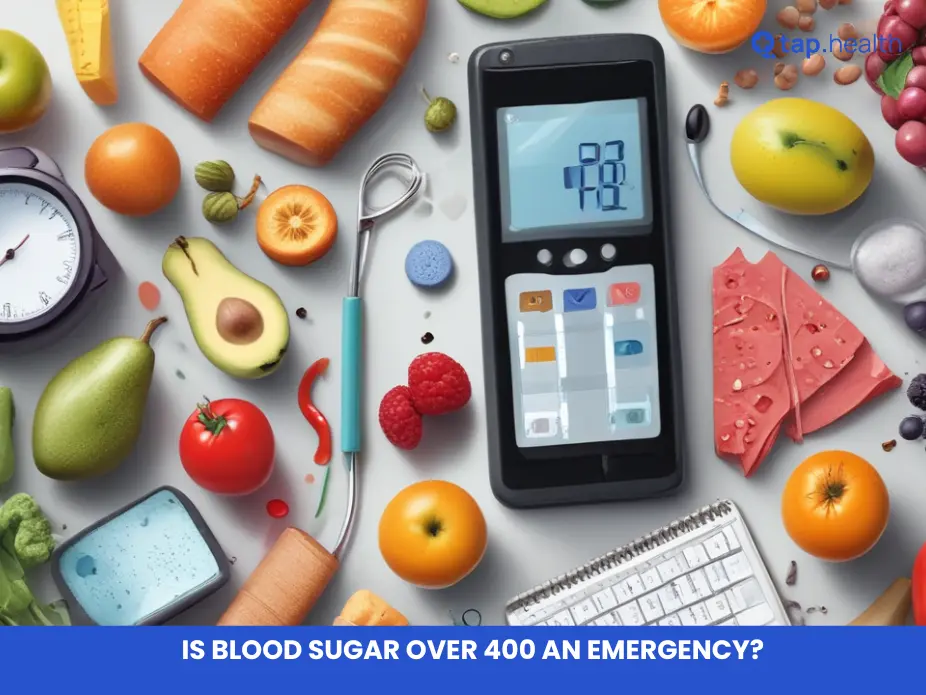Managing blood sugar levels is a crucial part of living with diabetes. But what happens when your blood sugar jumps to over 400 mg/dL? Is it an emergency? Let’s explore this important question in simple terms to help you understand the risks and the steps you should take.
Blood sugar, or blood glucose, is the main type of sugar found in your blood. It comes from the food you eat and gives your body the energy it needs to function. For people with diabetes, keeping blood sugar levels in a normal range is essential to avoid serious health problems. But when blood sugar levels rise above 400 mg/dL, things can get dangerous quickly. This blog will explain what it means when your blood sugar is over 400, the symptoms to watch for, and what actions you should take.
Understanding High Blood Sugar Levels
Defining Hyperglycemia in Context
High blood sugar, known medically as hyperglycemia, occurs when there is too much glucose in the blood. For most people, normal blood sugar levels are:
- Fasting (no food for 8 hours): 70-99 mg/dL
- After eating (2 hours): Less than 140 mg/dL
When blood sugar levels exceed these ranges, it can lead to health complications. Specifically, a blood sugar level over 400 mg/dL is considered extremely high and poses significant health risks.
Why Blood Sugar Levels Over 400 Are Concerning
A blood sugar level of 400 mg/dL or higher is extremely dangerous. At this level, the body struggles to use glucose properly, which can lead to life-threatening conditions like Diabetic Ketoacidosis (DKA) or Hyperosmolar Hyperglycemic State (HHS). These conditions require immediate medical attention to prevent severe health consequences.
What Does a Blood Sugar Level Over 400 Mean?
A blood sugar level over 400 mg/dL indicates that your body is not managing glucose effectively. This can happen for several reasons, such as insufficient insulin, illness, stress, or not following your diabetes management plan. When blood sugar levels reach this high, it disrupts your body’s normal functions and can lead to serious health issues.
Symptoms of High Blood Sugar to Watch For
Recognizing the symptoms of high blood sugar is vital to taking prompt action. Here are the signs to watch out for:
Early Warning Signs of Hyperglycemia
- Increased Thirst: Feeling unusually thirsty is one of the first signs of high blood sugar.
- Frequent Urination: Your body tries to get rid of excess sugar by making you pee more often.
- Fatigue: High blood sugar can make you feel tired and sluggish.
- Blurred Vision: Fluid loss can affect your eyes, causing blurred vision.
- Headaches: Dehydration and electrolyte imbalance can lead to headaches.
When Symptoms Escalate: Recognizing the Emergency Signs
If your blood sugar continues to rise, more severe symptoms can develop, indicating a medical emergency:
- Nausea and Vomiting: High levels of sugar can upset your stomach.
- Diarrhea: Fluid loss can lead to diarrhea.
- Dizziness: Low blood pressure from dehydration can cause dizziness.
- Confusion: Your brain may not function properly due to high sugar levels.
- Abdominal Pain: Pain in the stomach area can occur.
- Rapid Breathing: The body tries to compensate for acid buildup.
- Fruity-Smelling Breath: A sign of ketone production in the body.
Understanding the Risks of High Blood Sugar
Consistently high blood sugar levels can lead to serious health complications. It’s important to understand these risks to take proactive measures.
Short-Term Risks
- Dehydration: High blood sugar causes the kidneys to work harder to remove excess glucose, leading to dehydration.
- Electrolyte Imbalance: Loss of fluids can disrupt the balance of essential minerals in your body.
- DKA and HHS: These are life-threatening conditions that require immediate medical attention.
- Blurred Vision: High blood sugar can cause fluid to be pulled from tissues, including the lenses of your eyes.
- Headaches: Dehydration and changes in electrolyte levels can lead to headaches.
Long-Term Risks
- Heart Disease: High blood sugar can damage blood vessels, increasing the risk of heart attacks and strokes.
- Nerve Damage (Neuropathy): Excess sugar can harm the nerves, leading to pain, tingling, or numbness, especially in the feet and hands.
- Kidney Damage (Nephropathy): Diabetes can damage the kidneys, potentially leading to kidney failure.
- Eye Damage (Retinopathy): High blood sugar can harm the blood vessels in the eyes, increasing the risk of blindness.
- Foot Problems: Nerve damage and poor blood flow can lead to severe foot infections, sometimes requiring amputation.
- Skin Conditions: Diabetes can make you more susceptible to skin infections and other skin problems.
- Hearing Impairment: Diabetes may increase the risk of hearing problems.
- Alzheimer’s Disease: There is a higher risk of cognitive decline and Alzheimer’s disease in people with diabetes.
Understanding these risks highlights the importance of maintaining healthy blood sugar levels to prevent both immediate and long-term health issues.
Blood Sugar Over 400 Symptoms
When blood sugar levels exceed 400 mg/dL, the symptoms become more intense and alarming. You might experience:
- Severe Thirst and Dry Mouth: Extreme dehydration can make your mouth feel dry.
- Unusual Fatigue: Feeling extremely tired even after resting.
- Frequent Infections: High sugar levels can weaken your immune system.
- Slow-Healing Sores: Cuts and bruises may take longer to heal.
- Weight Loss: Losing weight without trying can be a sign of DKA.
Causes of 400 Blood Sugar Levels
Several factors can cause blood sugar levels to rise above 400 mg/dL:
- Insufficient Insulin: Whether you have type 1 or type 2 diabetes, not enough insulin can prevent glucose from entering your cells.
- Infection or Illness: Your body releases stress hormones during illness, which can increase blood sugar levels.
- Medications: Some medications, like steroids, can raise blood sugar.
- Stress: Physical or emotional stress can affect blood sugar levels.
- Diet: Consuming too many carbohydrates or sugary foods can spike blood sugar.
- Skipped Medications: Missing doses of insulin or other diabetes medications can lead to high blood sugar.
- Lack of Physical Activity: Regular exercise helps regulate blood sugar; inactivity can cause levels to rise.
Understanding these causes can help you identify potential triggers and take steps to prevent high blood sugar levels.
Is Blood Sugar Over 400 an Emergency?
Yes, a blood sugar level over 400 mg/dL is an emergency and requires immediate medical attention. At this level, your body is at risk of developing life-threatening conditions like Diabetic Ketoacidosis (DKA) or Hyperosmolar Hyperglycemic State (HHS). These conditions can lead to severe complications, including coma or death, if not treated promptly.
Is Blood Sugar Level of 400 Dangerous?
Yes, a blood sugar level over 400 mg/dL can be an emergency, especially if you experience symptoms or if it’s part of a larger condition called Diabetic Ketoacidosis (DKA) or Hyperosmolar Hyperglycemic State (HHS). These conditions can be life-threatening and require immediate medical attention.
Diabetic Ketoacidosis (DKA)
DKA is more common in people with type 1 diabetes but can occur in type 2 diabetes as well. It happens when the body starts breaking down fats for energy because it can’t use glucose properly. This process produces ketones, which can make the blood acidic.
Symptoms of DKA include:
- High blood sugar levels: Typically over 250 mg/dL, but can be higher.
- Ketones in the urine: Detected using ketone test strips.
- Frequent urination: The body tries to remove excess sugar through urine.
- Extreme thirst: Dehydration from frequent urination leads to intense thirst.
- Nausea and vomiting: High ketone levels can cause stomach upset.
- Abdominal pain: Discomfort due to acid buildup.
- Confusion or difficulty concentrating: The body’s altered chemistry affects brain function.
- Fruity-smelling breath: A sign of high ketone levels.
Causes of DKA:
- Missed insulin doses
- Severe illness or infection
- Physical or emotional stress
- Undiagnosed diabetes
Treatment for DKA:
- Insulin therapy: To reduce blood sugar and stop ketone production.
- Fluid replacement: To address dehydration.
- Electrolyte replacement: To balance essential minerals in the body.
- Treating underlying causes: Addressing infections or other triggers.
Hyperosmolar Hyperglycemic State (HHS)
HHS is more common in type 2 diabetes and is characterized by extremely high blood sugar levels without significant ketone production. It can lead to severe dehydration and other complications.
Symptoms of HHS include:
- Very high blood sugar levels: Often exceeding 600 mg/dL.
- Extreme thirst: Due to significant dehydration.
- Dry mouth and skin: Signs of fluid loss.
- Weakness or fatigue: The body lacks adequate energy.
- Confusion or altered consciousness: Severe dehydration affects brain function.
- Seizures: Resulting from extreme electrolyte imbalances.
- Coma: In severe cases, HHS can lead to unconsciousness.
Causes of HHS:
- Infections or illnesses
- Medications that increase blood sugar
- Poorly managed diabetes
- Dehydration
- Physical or emotional stress
Treatment for HHS:
- Intravenous fluids: To rehydrate the body.
- Insulin therapy: To lower blood sugar levels.
- Electrolyte replacement: To correct imbalances.
- Addressing underlying causes: Such as treating infections or adjusting medications.
What Happens When Your Blood Sugar Is 400?
When your blood sugar reaches 400 mg/dL, your body can no longer manage glucose effectively. Here’s what happens:
- Insulin Inefficiency: Without enough insulin, glucose cannot enter your cells to be used for energy.
- Fluid Loss: Excess glucose causes your kidneys to work harder to remove it from your blood, leading to dehydration.
- Ketone Production: In the absence of insulin, your body starts breaking down fats for energy, producing ketones that make your blood acidic.
- Organ Stress: High blood sugar puts stress on your organs, particularly the kidneys, heart, and eyes.
- Complications: If untreated, this can lead to DKA or HHS, both of which are medical emergencies.
What to Do If Your Blood Sugar Is Over 400
If your blood sugar is over 400 mg/dL, it’s essential to act quickly to lower your levels and prevent complications. Here’s what you should do:
Steps to Take
- Stay Calm: Panic can worsen the situation. Take deep breaths to remain calm.
- Check for Ketones: Use a ketone test strip to see if ketones are present in your urine. Ketones indicate that your body is breaking down fat for energy.
- Hydrate: Drink water or an electrolyte solution to help lower blood sugar levels and prevent dehydration.
- Take Insulin: If you use insulin, take your prescribed dose to help lower your blood sugar. Do not skip doses.
- Follow Your Sick Day Plan: If you have a diabetes management plan for illness, follow it carefully.
- Monitor Symptoms: Keep track of any new or worsening symptoms.
- Seek Medical Help: Contact your healthcare provider right away. If you experience severe symptoms like confusion, difficulty breathing, or loss of consciousness, call emergency services immediately.
When to Call 911
Call 911 or go to the emergency room if you experience:
- Difficulty Breathing: Trouble breathing can indicate severe complications.
- Severe Confusion or Unconsciousness: Indicates that your brain is not getting enough glucose.
- Persistent Vomiting: Unable to keep fluids down can lead to severe dehydration.
- Signs of DKA or HHS: Including fruity-smelling breath, rapid breathing, and extreme thirst.
- Severe Dehydration Symptoms: Such as very dry mouth, dizziness, or fainting.
- Seizures: Indicate a medical emergency that requires immediate attention.
Early intervention can prevent severe complications and save lives.
Tips for Managing High Blood Sugar Level Over 400
Managing high blood sugar levels effectively can help prevent emergencies. Here are some tips to keep your blood sugar under control:
1. Monitor Your Blood Sugar Regularly
Regular monitoring helps you understand how different foods, activities, and medications affect your blood sugar levels. Use a glucose meter or a continuous glucose monitor (CGM) to keep track.
2. Follow Your Treatment Plan
Take your medications or insulin as prescribed by your healthcare provider. Do not skip doses, and consult your doctor before making any changes to your treatment.
3. Eat a Balanced Diet
Focus on a diet rich in vegetables, whole grains, lean proteins, and healthy fats. Limit sugary snacks and beverages that can cause blood sugar spikes.
4. Stay Active
Regular physical activity helps your body use insulin more efficiently. Aim for at least 30 minutes of moderate exercise most days of the week.
5. Manage Stress
Stress can impact blood sugar levels. Practice stress-reducing techniques like deep breathing, meditation, or yoga.
6. Stay Hydrated
Drinking plenty of water helps your kidneys flush out excess sugar from your blood. Aim for at least eight glasses of water a day.
7. Get Regular Check-ups
Visit your healthcare provider regularly to monitor your condition and make necessary adjustments to your treatment plan.
8. Educate Yourself
Stay informed about diabetes and how to manage it. Understanding your condition empowers you to make better health choices.
9. Carry Medical Identification
Wear a medical ID bracelet or carry a card that identifies your diabetes. In an emergency, this can help first responders provide appropriate care quickly.
The Risks of Ignoring Blood Sugar Above 400
Ignoring high blood sugar levels can lead to severe health complications. Here’s why it’s crucial to address blood sugar levels over 400 mg/dL promptly.
Short-Term Complications: Immediate Risks
- Dehydration: Excess sugar causes your kidneys to remove more fluid from your blood, leading to dehydration.
- Electrolyte Imbalance: Loss of fluids can disrupt the balance of essential minerals like potassium and sodium.
- Diabetic Ketoacidosis (DKA): A life-threatening condition where the body breaks down fat for energy, producing ketones that make the blood acidic.
- Hyperosmolar Hyperglycemic State (HHS): A condition characterized by extremely high blood sugar and severe dehydration without significant ketone production.
Long-Term Health Consequences: What Happens If Left Untreated?
- Heart Disease: High blood sugar can damage blood vessels, increasing the risk of heart attacks and strokes.
- Nerve Damage (Neuropathy): Excess sugar can harm nerves, leading to pain, tingling, or numbness, especially in the feet and hands.
- Kidney Damage (Nephropathy): Diabetes can damage the kidneys, potentially leading to kidney failure.
- Eye Damage (Retinopathy): High blood sugar can harm the blood vessels in the eyes, increasing the risk of blindness.
- Foot Problems: Nerve damage and poor blood flow can lead to severe foot infections, sometimes requiring amputation.
- Skin Conditions: Diabetes can make you more susceptible to skin infections and other skin problems.
- Hearing Impairment: Diabetes may increase the risk of hearing problems.
- Alzheimer’s Disease: There is a higher risk of cognitive decline and Alzheimer’s disease in people with diabetes.
Understanding these risks highlights the importance of maintaining healthy blood sugar levels to prevent both immediate and long-term health issues.
Managing a Blood Sugar Crisis
When blood sugar levels soar above 400 mg/dL, managing the crisis effectively is essential to prevent severe complications.
First-Aid Measures for High Blood Sugar at Home
- Stay Calm: Keeping calm helps you think clearly and act appropriately.
- Hydrate: Drink water or an electrolyte solution to help reduce blood sugar levels and prevent dehydration.
- Take Your Medication: Administer your insulin or diabetes medication as prescribed.
- Check for Ketones: If you have a ketone test strip, check for ketones in your urine to assess the risk of DKA.
- Follow Your Sick Day Plan: If you have a plan for managing diabetes during illness, follow it carefully.
When to Seek Medical Help: Guidelines for Action
- Severe Symptoms: If you experience confusion, difficulty breathing, or loss of consciousness, seek emergency medical help immediately.
- Persistent Vomiting: If you can’t keep fluids down, go to the emergency room to prevent dehydration.
- Signs of DKA or HHS: Symptoms like fruity-smelling breath, rapid breathing, or extreme thirst indicate a medical emergency.
- No Improvement: If your blood sugar doesn’t come down after taking your medication, contact your healthcare provider.
Early intervention can prevent complications and save lives.
Prevention Strategies
Preventing blood sugar levels from rising above 400 mg/dL is crucial for managing diabetes effectively. Here are some strategies to keep your blood sugar in check:
Lifestyle Adjustments for Keeping Blood Sugar in Check
- Balanced Diet: Eat a variety of foods, including vegetables, whole grains, lean proteins, and healthy fats. Avoid excessive sugar and refined carbohydrates.
- Regular Exercise: Physical activity helps your body use insulin more efficiently. Aim for at least 30 minutes of moderate exercise most days.
- Stress Management: Practice relaxation techniques like deep breathing, meditation, or yoga to reduce stress levels.
- Adequate Sleep: Ensure you get enough restful sleep each night, as poor sleep can affect blood sugar levels.
Monitoring and Medication: Staying Ahead of High Blood Sugar Levels
- Regular Monitoring: Check your blood sugar levels as recommended by your healthcare provider to catch high levels early.
- Adhere to Medication: Take your diabetes medications or insulin as prescribed. Do not skip doses.
- Adjust as Needed: Work with your healthcare provider to adjust your treatment plan based on your blood sugar readings and lifestyle changes.
- Use Technology: Consider using a continuous glucose monitor (CGM) to keep track of your blood sugar levels in real-time.
Expert Opinions on High Blood Sugar Emergencies
Healthcare professionals emphasize the importance of recognizing the signs of extremely high blood sugar levels and taking swift action.
Dr. John Smith, Endocrinologist at Mayo Clinic
“A blood sugar level over 400 mg/dL is a red flag that should not be ignored. It can lead to severe complications if not addressed promptly. Patients should be educated on recognizing the symptoms and understanding when to seek emergency care,” says Dr. John Smith, an endocrinologist at Mayo Clinic.
American Diabetes Association (ADA)
The American Diabetes Association highlights that early intervention can prevent the progression of hyperglycemic emergencies. They recommend having a clear action plan in place and ensuring that those with diabetes understand how to manage their condition effectively. The ADA also stresses the importance of regular monitoring and adhering to treatment plans to avoid such emergencies.
Dr. Emily Johnson, Diabetologist at Cleveland Clinic
Dr. Emily Johnson from the Cleveland Clinic adds, “Education is key in diabetes management. Patients should work closely with their healthcare teams to understand their blood sugar patterns and the factors that influence them. This proactive approach can help prevent dangerous spikes in blood sugar levels.”
Conclusion
A blood sugar level over 400 mg/dL is a serious condition that can lead to life-threatening emergencies like Diabetic Ketoacidosis (DKA) and Hyperosmolar Hyperglycemic State (HHS). Recognizing the signs and taking prompt action can save lives and prevent long-term complications. By monitoring your blood sugar, following your treatment plan, maintaining a healthy lifestyle, and staying informed, you can effectively manage your blood sugar levels and reduce the risk of emergencies.
Always consult with your healthcare provider for personalized advice and treatment options. Your health is paramount, and taking proactive steps can make a significant difference in your well-being.
When to Seek Medical Help for High Blood Sugar Level
Knowing when to seek medical help is crucial in managing high blood sugar levels. Here’s when you should take action:
- Severe Symptoms: If you experience difficulty breathing, confusion, or unconsciousness, seek emergency medical help immediately.
- Persistent Vomiting: If you can’t keep fluids down, go to the emergency room to prevent dehydration.
- Signs of DKA or HHS: Symptoms like fruity-smelling breath, rapid breathing, or extreme thirst indicate a medical emergency.
- No Improvement: If your blood sugar doesn’t come down after taking your medication, contact your healthcare provider.
Prompt action can prevent severe complications and save your life.
FAQ on Is blood sugar over 400 an emergency?
1.Can Blood Sugar Over 400 Be Managed at Home?
In some cases, mild elevations above 400 mg/dL can be managed at home by following your diabetes management plan, such as taking your prescribed insulin, staying hydrated, and monitoring your blood sugar levels closely. However, if you experience severe symptoms or if your blood sugar remains high despite taking your medication, you should seek medical help immediately.
2.How Quickly Should You Act if Your Blood Sugar Is Over 400?
You should act immediately if your blood sugar is over 400 mg/dL. High blood sugar can escalate quickly into a medical emergency. Take steps to lower your blood sugar, such as taking insulin, hydrating, and monitoring your levels closely. If symptoms worsen or do not improve, seek emergency medical attention right away.
3.Are There Specific Diet Changes Recommended for High Blood Sugar?
Yes, specific diet changes can help manage high blood sugar levels. Focus on:
- Low-Carbohydrate Foods: Reduce intake of sugary foods and refined carbohydrates.
- Fiber-Rich Foods: Eat more vegetables, whole grains, and legumes to help stabilize blood sugar.
- Healthy Fats and Proteins: Include sources like nuts, seeds, lean meats, and fish to promote satiety and balanced blood sugar.
- Portion Control: Eating appropriate serving sizes helps avoid overeating and blood sugar spikes.
4.What Are the Signs That High Blood Sugar Is an Emergency?
Signs that high blood sugar is an emergency include:
- Confusion or Unconsciousness
- Difficulty Breathing
- Persistent Vomiting
- Fruity-Smelling Breath
- Rapid Breathing
- Severe Thirst or Dehydration
- Seizures
If you experience any of these symptoms, seek emergency medical help immediately.
5.How Does High Blood Sugar Differ for People with Type 1 vs Type 2 Diabetes?
While both type 1 and type 2 diabetes involve high blood sugar, the causes and management can differ:
- Type 1 Diabetes: Caused by the body’s inability to produce insulin. High blood sugar can quickly lead to DKA.
- Type 2 Diabetes: Caused by insulin resistance and sometimes insufficient insulin production. High blood sugar can lead to HHS, which is more common in older adults.
Both types require careful management to prevent extremely high blood sugar levels.
6.Is 400 Sugar Level Normal?
No, a blood sugar level of 400 mg/dL is not normal. It is considered extremely high and can lead to serious health complications. Normal blood sugar levels are typically between 70-99 mg/dL when fasting and less than 140 mg/dL after eating.
7.Can You Go Into a Diabetic Coma if Your Sugar Is 400?
Yes, extremely high blood sugar levels, such as 400 mg/dL or higher, can lead to a diabetic coma. Conditions like Diabetic Ketoacidosis (DKA) and Hyperosmolar Hyperglycemic State (HHS) can cause severe dehydration, electrolyte imbalances, and acid buildup in the blood, potentially leading to unconsciousness or coma.
8.What Will Happen If Blood Sugar Rises to 400?
If blood sugar rises to 400 mg/dL, your body struggles to use glucose effectively. This can lead to severe dehydration, electrolyte imbalances, and the development of DKA or HHS. Without prompt treatment, these conditions can cause organ damage, coma, and even death.
9.Is a 400 to 500 Blood Sugar Level Dangerous?
Yes, a blood sugar level between 400 to 500 mg/dL is highly dangerous. It significantly increases the risk of developing life-threatening complications like DKA and HHS. Immediate medical attention is necessary to lower blood sugar levels and prevent severe health issues.



